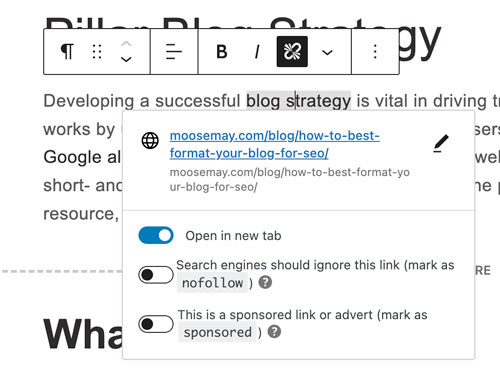Developing a successful blog strategy is vital in driving traffic to your website. The pillar blog format works by using the information we know about how users interact with search engines and the Google algorithm to increase authentic traffic to your website. This blogging strategy produces both short- and long-term results. It sets your website on the path to creating organic traffic as a trusted resource, thereby increasing your search rankings.
What is a Pillar Blog?
Put simply, a pillar blog is a large, substantial blog post that typically ranges between 2,000 and 4,000 words. These blogs are well-written, engaging, and chock full of pertinent information. In addition, a pillar blog will provide the reader with an abundance of related information like hyperlinks, pictures, videos, and graphs that support the topic being discussed.

What sets a pillar blog apart from the average blog post is its endurance. A typical blog is intended to address a specific topic and will rise in popularity for a short amount of time, typically a few days or weeks. On the other hand, a pillar blog is broader and intended to be a reliable source that will last for months or even years.
How Does the Pillar Blog Strategy Work?
A pillar in the architectural world is a physical beam that supports a building. A pillar blog works the same way for your website. The job of the pillar blog is to support a multitude of smaller blogs, called cluster blogs using hyperlinks and keywords. Incorporating the pillar/cluster blog format into your blog strategy will drive more authentic traffic to your website.
Pillar Blog Strategy Terms to Know
Cluster Blogs
Hyperlinks
What is a Cluster Blog?
Cluster blogs play an integral role in the pillar blog strategy. While a pillar blog aims to touch on all potential questions on a subject, the cluster blogs are shorter and more specific answers to these questions. The cluster blog aims to support and enhance the pillar blog content. Cluster blogs are typically 500-1,000 words each.
Your cluster blogs will all work together to create comprehensive information for your pillar blogs. The pillar blogs and cluster blogs work together to create a circle of related information. Cluster blogs all link back to the central pillar blog, and the pillar blog links to the individual cluster blogs.
Depending on your blog strategy, you may update or add cluster blogs every few days or weeks. However, a strong pillar blog will outlast the cluster blogs while remaining relevant as new cluster blogs are added.
Hyperlinking Pillar and Cluster Blogs

For the pillar/cluster blog strategy to be effective, hyperlinking is necessary. While creating your pillar blog, you will provide answers to all related questions without going too in-depth. On the other hand, when developing cluster blogs, the goal is to answer the broad questions from the pillar blog more thoroughly.
Hyperlinking from the pillar blog directly to the related cluster blog allows readers to find the more specific information they need without leaving your website. In the same way, when you link from a cluster blog back to the pillar blog, you enable the reader to gain expanded access to a subject. This blogging strategy organizes your blog content for a more user-friendly experience, allowing readers to jump from blog to blog within your website, learning more about a topic.
Internally linking to related topics and keywords signals to Google that your website is an authority on a topic. When Google views your website as authentically knowledgeable, your blog posts and website can rank higher in search results.
Keyword Blog Strategy
The way we search on the internet has changed and evolved over the years, which means our blog strategy for bringing in and maintaining traffic must also evolve. These changes are attributed to many things, including an increase in information streams and an increase in the ways we access this information.
Searching has expanded beyond the search bar on a desktop. Typing on our phones and voice-to-text affects how we phrase our questions. When looking online for a restaurant or a gift for a loved one, the search process has become more conversational and personalized. “Gift for husband” has been replaced with “gift for husband who loves sports.” Keywords are typically four words or more.
Pillar blogs focus on broad keywords with high search volumes, while cluster blogs focus on more specific keywords that produce smaller search volumes. This pillar blog strategy uses the pillar blog to increase traffic to your website on a specific topic. Once a user has accessed your pillar blog, they are linked to your cluster blogs, leading to a rise in rankings.
When writing a bunch of small blogs on one topic using a variation of the same keywords, you are fighting against yourself in Google rankings. Instead, the pillar blog strategy allows your cluster blogs to rank for the same broader topic. First, choose the broad topics you want to cover on your website, then use this as an outline for creating content based on specific keywords related to that broad topic.
Pillar Blog Strategy Benefits

- Streamlines website traffic
- Raises overall content rankings
- Organizes your website
- Creates trust and integrity with users and Google analytics
The pillar blog strategy streamlines traffic to your website, enabling your overall rankings to rise for both your pillar and cluster blog content together. It creates a well-rounded appeal to your website. It also organizes your website for those accessing it and those developing it.
Website organization is not only beneficial to the user when trying to locate specific information; it also aids in planning content. With the pillar blog strategy, you establish the main goals and topics for your website, which becomes a guide for further cluster content to hyperlink back to the pillar blogs.
Providing quality content that hyperlinks to even more quality content within your website increases trust for the user. It also creates trust and integrity in regard to Google analytics. Thus, the pillar blog strategy is a winning combination of organized, planned content and authentic and organic growth for your website.
